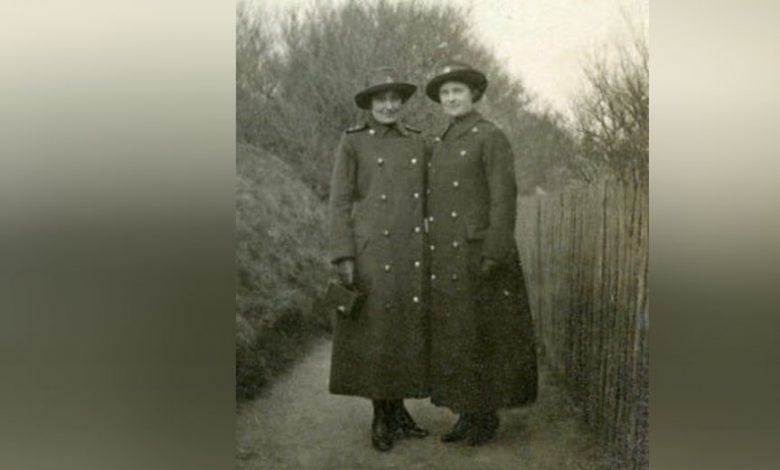
Women’s History Month: Canadian Army Medical Corps Nurse Gladys (Matheson) Crim
October is and girls from our past, and our present, who are contributing to a better, more inclusive Canada. On Saskatchewan.ca is a wonderful article we came across the below article about Gladys Elizabeth Matheson.
Gladys Elizabeth Matheson was born September 27, 1892, at the Onion Lake Mission in the North-West Territories to Reverend John Richard Matheson and Dr. Elizabeth (Scott) Matheson, the first woman doctor to practice in the North-West Territories. Gladys worked with her mother at the Mission’s hospital before moving to Winnipeg in 1914 to train as a nurse at the Winnipeg General Hospital.
Tragedy struck her in 1916 with the passing of both her father and her fiancé, Gerald Barnes, who was killed in the Battle of the Somme. Despite this tragedy, she completed her training in 1917 and enlisted for military service as a nursing sister. She was almost immediately called to begin her service at the Tuxedo Military Hospital in Winnipeg. She served there until she was drafted to be sent overseas with the 25th Draft of the Canadian Army Medical Corps as a Lieutenant Nursing Sister. Gladys and her fellow nursing sisters arrived in St. John, New Brunswick on December 17, the day of Canada’s 13th federal election. Complete enfranchisement of women didn’t take effect until 1918, but the Wartime Elections Act had given the vote to all people on active service. Gladys was one of the first women in Canada to vote in the election, before leaving for Europe.
The nursing sisters, along with 1,400 troops, boarded the RMS Missanabie for the trip to Europe. After stopping in Halifax to take more passengers on board, the ship departed on December 21, 1917. They expected to land in Liverpool, England, but instead disembarked at Glasgow, Scotland on December 31. Gladys and her fellow passengers soon learned that the pilot boat coming from Liverpool to meet them had been torpedoed by a German U-Boat, so their ship was diverted. Eight months later, the Missanabie was torpedoed and sunk off the coast of Ireland.
Gladys and the other nursing sisters arrived in London on New Year’s Day. From there she, along with her good friend and fellow nurse Veronica Page, was assigned to the No. 14 Canadian General Hospital at Eastbourne on the south coast of England. Gladys worked in the operating room where for the first time she saw “the torn and mutilated bodies of strong young men from the battlefields of France, and assisted in radical operations to save them from death, but often from the amputation of limbs, and seldom with hope that they could be restored to complete health again” (PAS, R-E1395, File 4, Gladys (Matheson) Crim fonds, script prepared from the wartime diaries of Gladys Matheson 1917-1919, p.11).
In March, 1918, Gladys and Veronica requested to serve in France. Their requests were granted, and in May they reported to the No. 3 Canadian General Hospital at Boulogne. The hospital consisted of groups of huts, with three huts making up a ward. Each hut was supposed to accommodate 25 patients, but the German offensive meant that overcrowding was common. Gladys served in a medical ward that treated illnesses like pneumonia and shellshock, which was only beginning to be recognized as a serious condition.
On May 19, Gladys and Veronica experienced their first air-raid. Their hospital was on the edges of the raid, which was actually directed at nearby Étaples where the hospitals suffered heavy casualties, including three Canadian nursing sisters. One casualty, Margaret Lowe, was a former colleague of Gladys in Winnipeg.
In early August, 1918, Gladys was transferred to a surgical ward at the hospital. She was working there when the Battle of Amiens resulted in the arrival of heavy convoys of wounded Canadian and Australian soldiers.
When lulls in fighting allowed them the time, Gladys and the other nurses found ways to keep their spirits up. Some of the hospitals formed baseball teams, and Gladys and her friend cheered on the team from the No. 3 Hospital. They swam in the ocean, attended dinners and dances, and went to picture shows and concerts in Boulogne, including a performance of the opera Rigoletto at the Boulogne Opera House.
In October 1918, Gladys and Veronica were granted two weeks leave from the hospital, which they used to visit Scotland. They returned to France on November 5, in time to celebrate the end of the war in Boulogne. Although the war was over, the hospital continued to be busy. The Spanish flu was rampant, and the wards filled with influenza patients, as well as those with other conditions who had been prisoners of war. Gladys and Veronica remained in France until March 8, 1919, by which time the hospital was nearly empty. Gladys returned briefly to No. 14 Canadian General Hospital in Eastbourne before leaving for Canada on May 24. She arrived ten days later and reported for duty again at Tuxedo Military Hospital in Winnipeg. Her service in the Canadian Army Medical Corps continued for another year until she was demobilized in July 1920.
Following her military service Gladys continued working a nurse. In 1926 she married Sterling Crim, a U.S. infantry officer, and moved to San Antonio, Texas. She returned to Canada in the 1980s after Crim’s death. Gladys and Veronica Page remained friends the rest of their lives.
Gladys (Matheson) Crim passed away on July 22, 1991, at the age of 99. The Gladys (Matheson) Crim fonds (R-E1395), including wartime diaries, reminiscences of wartime experiences, an autograph album, and photographs, can be viewed at the Provincial Archives of Saskatchewan.
For the latest information and for more updates on everything Kindersley ‘Like’ the Kindersley Social Facebook page below…








































